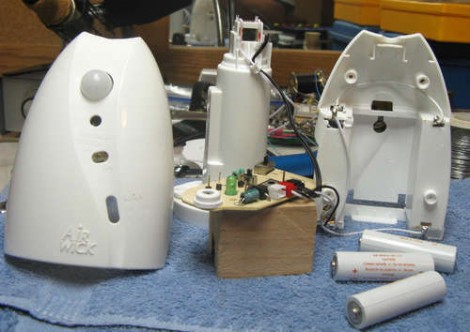
[Hunter’s] wife came home from her latest extreme couponing session with a handful of free Air Wick Odor Detect air fresheners, and since they had so many of the things sitting around, he was compelled to take one apart to see what makes them tick.
The casing was secured with melted snap tabs which had to be cut, making disassembly a one-way street. Once opened, he found a trio of white label AA cells and an ARNIE COMPACT3 ISS.4 controller board, complete with an epoxy-sealed microcontroller. A similarly branded sensor board was attached to the controller, and he spotted a solenoid with a built-in nozzle for spraying air freshener as well.
The sensor board piqued his curiosity the most, and after some research he’s pretty sure that the Air Wick uses an Applied Sensor VOC air quality module to get the job done. The tiny sensor uses a special substrate containing electrodes, which measure the resistance of the sensing layer while it is heated to upwards of 400° C. A change in resistance lets the air freshener know that it’s time to handle the odoriferous emanations floating about.
Thanks to [Hunter] for taking the time to tear the Air Wick down and letting us know what’s inside!












